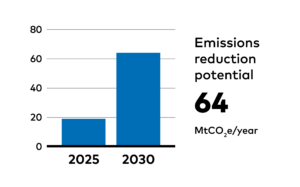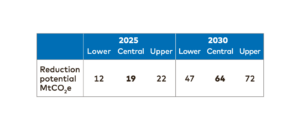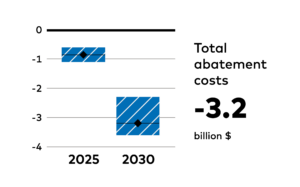Climate impact
In 2014, heat pumps in Sweden delivered 14 TWh of heat. This translates into 1/5 of the total space and water heating demand. The annual growth since 2005 has been 8.4%.
Scaling up the solution to selected European countries would increase energy provided with heat pumps by almost 400 TWh above the baseline in 2030. Taking into account the emissions from powering the pumps, this would result in an emission reduction of 64 Mt in 2030. The impact may seem small as the target countries are expected to increase the use of heat pumps already in the baseline.


Success factors
Heat pumps allow for more efficient heating by taking heat energy from outside and with the help of electrical work pumping that energy indoors as heat, effectively acting as a refrigerator in reverse. Heat pumps can save energy by providing 2–4 units of heat for each unit of electricity used.
Most Nordic countries excel in installing heat pumps for residential heating. Sweden has had the world’s highest number of heat pumps per population.
In the early 1990s Sweden launched a well-coordinated programme with activities on testing, certification, subsidies and information. The focus was on knowledge development, networking and market formation, but also on quality control, credibility and legitimacy.
The Swedish Energy Agency (SEA) has had a big role in supporting this development, mainly through its financial support for the Effsys and Effsys2 research programmes. Between 1975 and 2008 the government invested around SEK 200 million in heat pump R&D.
SEA has been testing heat pumps since 2004 to help consumers to choose a product that best fits their needs regarding energy efficiency, noise levels, price and quality. The webpage presenting test results of heat pumps had about 366,000 visits in 2014 alone.
The programme boosted demand for heat pumps with sales doubling from 1995 to 1996. Between 1996 and 2006 the number of installations increased at an average of 35% per year. During the past three decades, costs have been reduced by more than a factor two. Today, heat pumps are cost‐competitive with fossil fuels. Important drivers of the cost reduction have been the economies of scale for heat pumps and borehole drilling as well as continuous technology improvements.
“Heat pumps can provide 2–4 units of heat for each unit of electricity used.”
Costs
Retrofitting residential heat pumps come at a negative abatement cost of –52 $/tCO2. Scaling up the solution would result in total costs of –$3.2 billion in 2030.


Co-benefits
Residential heat pumps can provide several co-benefits, including
- cutting harmful air pollution
- improving energy security
- reducing fuel imports
Barriers and drivers
Heat pumps save money over time by cutting heating bills, but they also require investment. Since up-front cost typically weighs more heavily than net cost over time for individual consumers, some form of subsidy or tax incentive may help to drive adoption, especially in markets with low energy prices.
The emission and economic savings for heat pumps are reduced by measures that cut heat loss, such as improved insulation. It also competes directly with district heating where that is available. On the other hand, heat pumps can be seen as a complement to district heating in lower-density areas and for individual homes for which district heating is not an option.
As heat pumps can also be used for cooling, they may increase power use during summer. An increase in summer time load may be mitigated by installing solar power, for instance.






RELATED SOLUTIONS